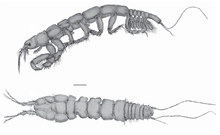Longiflagrum amphibium
Longiflagrum amphibium is an estuarine species of crustacean in the order Tanaidacea. It is known only from the type locality, which is the intertidal zone at Port Hedland, Northwestern Australia.[1]
| Longiflagrum amphibium | |
|---|---|
 | |
| Holotype (♀) of Longiflagrum amphibium. Top: lateral view. Bottom: dorsal view. Scale bar: 1 mm. | |
| Scientific classification | |
| Kingdom: | |
| Phylum: | |
| Subphylum: | |
| Class: | |
| Order: | |
| Family: | Parapseudidae |
| Genus: | Longiflagrum |
| Species: | L. amphibium |
| Binomial name | |
| Longiflagrum amphibium Stępień & Błażewicz-Paszkowycz, 2009[1] | |
Description
Longiflagrum amphibium can be distinguished from the other four species of the genus Longiflagrum by having the shortest flagellum in the antennule and by its oval pleopod basis.[1] The specific name amphibium is from the Latin for "amphibious". The name reflects the species' presence in the intertidal zone.[1]
Ecology
All five Longiflagrum species occur in shallow coastal habitats such as the intertidal zone, eelgrass beds and estuaries where the salinity fluctuates over the range 5–34 psu,[2][3] and they are a frequent and abundant element of the soft-bottom ecosystem.[1][2]
References
- Anna Stępień & Magdalena Blazewicz-Paszkowycz (2009). Neil Bruce (ed.). "Advances in the taxonomy and biogeography of Crustacea in the Southern Hemisphere: Longiflagrum amphibium, a new estuarine apseudomorph tanaid (Crustacea, Peracarida) from north-western Australia". ZooKeys (18): 161–170. doi:10.3897/zookeys.18.154.
- Donald F. Boesch (1973). "Three new tanaids (Crustacea, Tanaidacea) from southern Queensland". Pacific Science. 27 (2): 168–188. hdl:10125/792.
- Saowapa Angsupanich (2004). "A new species of Longiflagrum (Tanaidacea, Parapseudidae) from Songkhla Lagoon, Thailand". Crustaceana. 77 (7): 849–860. doi:10.1163/156854004774248726. JSTOR 20105764.
External links
